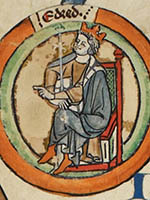
Kings and Queens
Discover the stories of the Monarchs

Kings and Queens in Politics
Choose your Monarch

From Celtic to Modern Times
The great and not so great RULERS

Aethelred II, also known as Aethelred the Unready, was the King of England from 978 to 1013 and again from 1014 to 1016. He was the son of King Edgar and was only about 10 years old when he became king. His reign was marked by a series of Viking invasions and the payment of large sums of money, known as Danegeld, to the invaders in an attempt to buy peace. Despite this, the Vikings continued to ravage England, and Aethelred's lack of success in dealing with them led to his nickname "the Unready." He was eventually forced to flee to Normandy in 1013 and was replaced by Sweyn Forkbeard, a Danish king. Aethelred returned to England in 1014 and regained the throne, but he died the following year. His reign is considered to be a low point in English history due to the constant Viking attacks and the weakness of Aethelred's leadership.
 Aethelred II, also known as Aethelred the Unready, was the King of England during the late 10th and early 11th century. Here are some of the important issues and events of his reign:
Aethelred II, also known as Aethelred the Unready, was the King of England during the late 10th and early 11th century. Here are some of the important issues and events of his reign:
Viking invasions: Aethelred's reign was marked by a series of Viking invasions. Despite paying large sums of money, known as Danegeld, to the invaders in an attempt to buy peace, the Vikings continued to ravage England. Aethelred was unable to effectively deal with these invasions and this led to his nickname "the Unready."
St. Brice's Day massacre: In 991, Aethelred ordered the killing of Danish settlers in England in an attempt to stem the tide of Viking invasions. This event, known as the St. Brice's Day massacre, led to increased hostilities between England and Denmark.
Political instability: Aethelred's weak leadership led to political instability within England. He was forced to flee to Normandy in 1013 and was replaced by Sweyn Forkbeard, a Danish king. Aethelred returned to England in 1014 and regained the throne, but he died the following year.
The rise of the Danelaw: During his reign, the Vikings established a large and powerful presence in England, known as the Danelaw. This area, which covered much of northern and eastern England, was ruled by Danish law and had its own system of government.
Church and Monastery: Aethelred was involved in several conflicts with the Church, including the murder of Saint Alphege, the Archbishop of Canterbury in 1012, which led to a temporary exile for Aethelred in Normandy. He also was known for his support of monastic communities and the building of monasteries.
Overall, Aethelred's reign was marked by a lack of success in dealing with the Viking invasions, political instability, and conflicts with the Church, which led to a decline in the power and prestige of the English monarchy during this period.
Reference: Article by Greg Scott (Staff Historian), 2023
Tour Reviews
History Attractions
Submit Tour Suggestions
2024 Departures
Spotlight Tours
Events and anniversaries

All content and images are protected by copyright to Access History